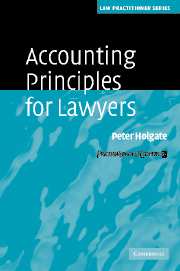Book contents
- Frontmatter
- Contents
- Acknowledgements
- Glossary of terms
- Part I The accounting environment
- Part II Some specifics
- 8 Individual entity accounts and consolidated accounts
- 9 Mergers and acquisitions
- 10 Interaction of accounting with tax
- 11 Assets
- 12 Liabilities
- 13 Leases
- 14 Pensions
- 15 Financial instruments, including capital instruments
- 16 Realised and distributable profits
- 17 Disclosures in published accounts
- 18 Use of financial information in contracts and agreements
- Appendices
- Index
11 - Assets
from Part II - Some specifics
Published online by Cambridge University Press: 28 July 2009
- Frontmatter
- Contents
- Acknowledgements
- Glossary of terms
- Part I The accounting environment
- Part II Some specifics
- 8 Individual entity accounts and consolidated accounts
- 9 Mergers and acquisitions
- 10 Interaction of accounting with tax
- 11 Assets
- 12 Liabilities
- 13 Leases
- 14 Pensions
- 15 Financial instruments, including capital instruments
- 16 Realised and distributable profits
- 17 Disclosures in published accounts
- 18 Use of financial information in contracts and agreements
- Appendices
- Index
Summary
Introduction
The key questions that arise in relation to assets are: what is the definition of assets; which assets are recognised on balance sheet, and when are they first recognised; and how are the assets that are recognised on balance sheet measured. There are also questions of how assets should be classified and presented on balance sheets; and questions of depreciation. These issues are considered in turn.
In a formal sense, the UK Statement of principles (para. 4.6) defines assets as: ‘rights or other access to future economic benefits controlled by an entity as a result of past transactions or events’. Less formally, an asset is something of value that a company has.
Recognition of assets
From the definition, it might appear that all a company's assets are recognised on the balance sheet. In fact, they are recognised only if they pass certain recognition criteria, for example that they can be measured with sufficient reliability. For this reason, and in some cases because the asset in question is not controlled by the company, assets such as a company's reputation, its skilled workforce and its self-developed brands – valuable though they may be – are not recognised on balance sheet.
Measurement of assets
Traditionally, accounting has been strongly based on historical cost. As noted in chapter 7 at p. 72, one of the recent developments in accounting is the increased use of fair value or a similar valuation basis, resulting in a mixed measurement model.
- Type
- Chapter
- Information
- Accounting Principles for Lawyers , pp. 117 - 121Publisher: Cambridge University PressPrint publication year: 2006



